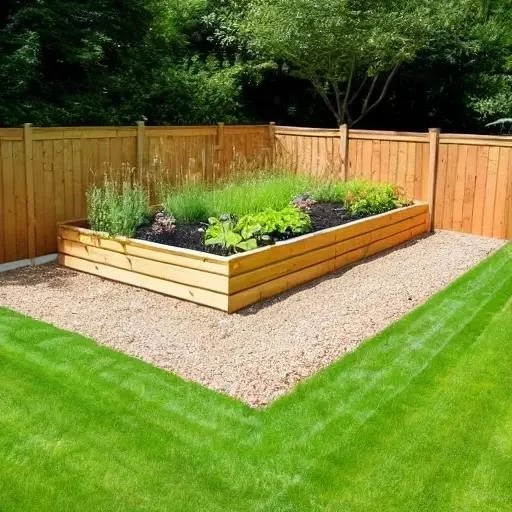In a world increasingly seeking solace and beauty in the natural world, the humble garden has emerged as a profoundly personal sanctuary. But what if there was a remarkably simple yet incredibly effective way to elevate your gardening game, transforming mundane patches into vibrant, thriving spectacles? Enter the raised flower garden bed – a horticultural marvel that promises not just blooms, but an entirely reimagined gardening experience. This isn’t merely about planting; it’s about crafting an optimized environment where your botanical aspirations can flourish with unparalleled vigor.
Envision a garden free from the relentless tyranny of poor soil, intrusive weeds, and back-breaking labor. A thoughtfully designed raised bed offers precisely this liberation, providing an elevated, controlled ecosystem that nurtures plants from root to petal. By strategically positioning and constructing these beds, you’re not just growing flowers; you’re cultivating a dream, ensuring superior drainage, enhanced soil quality, and an extended growing season. It’s a forward-looking approach to gardening, one that empowers enthusiasts of all skill levels to achieve breathtaking results, effortlessly blending aesthetics with practicality in their outdoor spaces.
Essential Insights for Your Raised Garden Bed Project
Embarking on the journey of creating a raised flower garden bed is an exciting endeavor. To ensure your project is a resounding success, here’s a comprehensive overview of key considerations, materials, and benefits, presented in an easy-to-digest format suitable for planning and reference.
| Category | Details / Information | Reference / Link |
|---|---|---|
| Key Benefits |
| |
| Recommended Materials |
| HGTV ⎻ How to Build a Raised Garden Bed |
| Ideal Soil Composition |
| Oregon State University Extension ⎯ Soil Mixes |
| Essential Tools |
| Fine Gardening ⎯ Building a Raised Bed |
Designing Your Botanical Masterpiece: The Art of Placement and Material Selection
The journey to a flourishing raised bed begins long before the first shovel hits the earth. It commences with thoughtful design and meticulous planning, factors that will undeniably shape your garden’s future success. Horticulturalists often emphasize the critical importance of location: choose a spot receiving at least six hours of direct sunlight daily for most flowering plants. Consider proximity to a water source, simplifying future irrigation. Furthermore, envisioning the bed’s dimensions and shape – whether a classic rectangle, an elegant L-shape, or a whimsical curvilinear design – is vital. These initial choices are like laying the foundation for an architectural wonder, ensuring both structural integrity and aesthetic harmony within your landscape.
Selecting the right materials is another pivotal decision, profoundly impacting both longevity and visual appeal. Cedar and redwood are remarkably popular choices, celebrated for their natural resistance to rot and insects, promising years of beauty without chemical treatments. For a more modern, industrial aesthetic, galvanized steel or corrugated metal beds offer sleek lines and incredible durability. Stone or brick, while requiring more intensive initial labor, provide timeless elegance and exceptional thermal mass, helping to regulate soil temperature. By carefully weighing these options against your budget, desired aesthetic, and long-term maintenance preferences, you are actively crafting a resilient and beautiful home for your future blooms.
From Foundation to Flourish: Constructing Your Raised Bed with Precision
With your design finalized and materials gathered, the construction phase commences – a deeply satisfying process that transforms raw components into a functional gardening structure. Begin by clearing the chosen site, ensuring it is level and free of debris. Many experts recommend laying down a protective barrier, such as cardboard or landscape fabric, at the bottom of your bed to suppress weeds effectively while still allowing for drainage. For wooden beds, assembling the frame with durable fasteners like galvanized screws or deck screws ensures robust construction, capable of withstanding the pressures of soil and weather. Precision in measurement and leveling during this stage is paramount, preventing future structural issues and ensuring an attractive, professional finish.
Once the frame is securely in place, the true magic of the raised bed begins to unfold: filling it with an optimal soil blend. This is where you gain an enormous advantage over traditional in-ground gardening. Leading landscape designers advocate for a rich, well-draining mix, typically comprising high-quality topsoil, generous amounts of organic compost, and amendments like perlite or vermiculite to enhance aeration. This carefully concocted “super-soil” provides an unparalleled nutrient-rich environment, fostering vigorous root development and robust plant growth. By integrating these insights from soil science, you are not just filling a box; you are engineering a miniature, fertile biome designed for spectacular floral displays, ensuring your flowers receive the absolute best start in life.
Cultivating Success: Planting and Nurturing Your Vibrant Blooms
With your raised bed meticulously constructed and filled with its nourishing substrate, the stage is set for planting – the joyous culmination of your efforts. When selecting flowers, consider their mature size, light requirements, and companion planting benefits. Taller varieties can form a stunning backdrop, while shorter, trailing plants can gracefully spill over the bed’s edges, creating a lush, overflowing appearance. Remember the adage: “right plant, right place,” ensuring each bloom thrives in its designated spot. After planting, a thorough initial watering helps settle the soil around the roots, initiating the crucial process of establishment.
Maintaining the vitality of your raised bed is remarkably straightforward, owing to its inherent advantages. The controlled environment means less competition from weeds, and the superior drainage mitigates issues of root rot. Consistent watering, especially during dry spells, is crucial, though raised beds often retain moisture more efficiently than conventional gardens. Fertilize judiciously, perhaps with a slow-release organic granular fertilizer or a liquid feed every few weeks, to replenish nutrients consumed by your actively growing plants. By diligently observing your flowers for signs of stress or pests and addressing them promptly, you are not merely gardening; you are engaging in a dynamic, rewarding partnership with nature, cultivating beauty that inspires and sustains.
A Future in Full Bloom: The Lasting Legacy of Your Raised Garden Bed
Embracing the raised flower garden bed transcends a simple gardening project; it represents a commitment to a more efficient, enjoyable, and sustainable approach to cultivating beauty. The long-term benefits are manifold: from reduced water usage due to targeted irrigation to the continuous enrichment of your soil through annual compost additions. This gardening method empowers you to continually adapt and refine your horticultural endeavors, experimenting with new varieties and designs with ease. Ultimately, a well-tended raised bed is more than just a place where flowers grow; it is a vibrant testament to ingenuity, a thriving ecosystem, and a constant source of joy and inspiration, promising a future where your garden truly flourishes.






